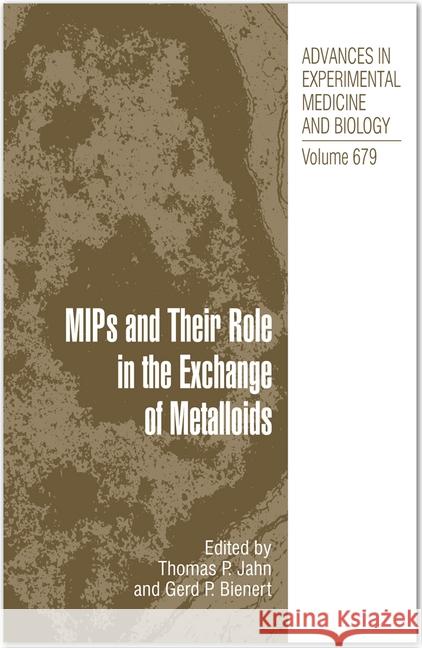MIPS and Their Roles in the Exchange of Metalloids » książka



MIPS and Their Roles in the Exchange of Metalloids
ISBN-13: 9781493941001 / Angielski / Miękka / 2016 / 145 str.
MIPS and Their Roles in the Exchange of Metalloids
ISBN-13: 9781493941001 / Angielski / Miękka / 2016 / 145 str.
(netto: 575,06 VAT: 5%)
Najniższa cena z 30 dni: 578,30
ok. 22 dni roboczych.
Darmowa dostawa!
This book covers metalloids, a recently discovered group of substrates for specific MIPs in a diverse spectrum of organisms.
Particular focus is placed on boron, silicon and arsenic, and on exchange of metalloids between organisms and their environment.
1. Aquaporins: A Family of Highly Regulate d Multifunctional Channels Charles Hachez and François Chaumont Abstract Introduction—The Discovery of Aquaporins Topology of Aquaporins Selectivity of Aquaporins Measurement of Aquaporin Activity and Water Movement Aquaporin Inhibition Phenotype Analysis Reveals Involvement of Aquaporins in Key Physiological Processes Aquaporin Regulation: Gating and Localization Conclusion 2. Phylogeny of Major Intrinsic Proteins Jonas Å.H. Danielson and Urban Johanson Abstract Introduction A Historical Account of the MIP Phylogeny Plant MIPs Phylogenetic Analysis of NIPs Solute Transport NIP?Like Bacterial MIPs and Ancestral State of ar/R Filter Conclusion 3. Metalloids, Soil Chemistry and the Environment Enzo Lombi and Peter E. Holm Abstract Introduction Historical Perspective Environmental Relevance Factors Controlling Bioavailability Assessing Soil Bioavailability of Metalloids Conclusion 4. Arsenic Transport in Prokaryotes and Eukaryotic Microbes Barry P. Rosen and Markus J. Tamás Abstract Introduction Metalloid Transport in Prokaryotes Metalloid Transport in Eukaryotic Microbes Conclusion 5. Metalloid Transport by Aquaglyceroporins: Consequences in the Treatment of Human Diseases Rita Mukhopadhyay and Eric Beitz Abstract Introduction Metalloids and Cancer Uptake of Metalloids via Human Aquaglyceroporins Metalloids in Protozoan Parasitic Infections Parasite Aquaglyceroporins Facilitate Metalloid Transport Therapeutic Modulation of AQP Permeability Conclusion 6. Roles of Vertebrate Aquaglyceroporins in Arsenic Transport and Detoxification Zijuan Liu Abstract Introduction Expression of Vertebrate Aquaglyceroporins Arsenic Is Both an Environmental Toxin and Human Carcinogen Uptake of Organic and Inorganic Arsenic via Aquaglyceroporins Molecular Mechanisms for Arsenic Translocation by Aquaglyceroporins Arsenic Toxicity in Relation of Aquaglyceroporins Regulation Perspectives Conclusion 7. Molecular Mechanisms of Boron Transportin Plants: Involvement of Arabidopsis NIP5;1 and NIP6;1 Kyoko Miwa, Mayuki Tanaka, Takehiro Kamiya and Toru Fujiwara Abstract Physiological Function of Boron in Plants Physiological Analysis of B Transport Molecular Mechanisms of B Transport Improvement of Plant Growth Property through BOR and NIP Transporters Conclusion and Foresights 8. Silicon Transporters in Higher Plants Jian Feng Ma Abstract Introduction Silicon Transporters Influx Si Transporters Efflux Transporter of Silicon Difference in Si Uptake System between Paddy and Field Crops Silicon Transporters for Xylem Unloading Conclusion 9. Major Intrinsic Proteins and Arsenic Transport in Plants: New Players and Their Potential Roles Gerd P. Bienert and Thomas P. Jahn Abstract Introduction The Challenge of As Speciation in Plants Transport of As in Plants What Do the Different “Omics” Tell Us About NIP?Mediated As Transmembrane Transport? The Physiological Role of NIPs Plant NIPs Transport Trivalent Antimony Conclusion 10. Major Intrinsic Proteins in Biomimetic Membranes Claus Hélix Nielsen Abstract Introduction Biomimetic Membranes MIP Biomimetic Membranes and Osmotic Processes Conclusion Index
Thomas P. Jahn is an Associate Professor and group leader at the Department of Agriculture and Ecology, Faculty of Life Sciences, University of Copenhagen. He studied biology at the University of Bonn, Germany. From early on in his scientific career he was interested in transport processes in plants and the molecular mechanisms behind these processes. More recently his group contributed to the field of aquaporin research culminating in the identification of several new substrates for members of this superfamily of channel proteins. The overall scope of his current research focuses on the elucidation of networks comprising molecular components engaged in the responses to nutritional stresses, including elements of transport, assimilation, storage and stress signaling. Gerd P. Bienert is currently a Marie Curie Fellow at the Institute of Life Science at the Université Catholique de Louvain in Louvain la Neuve, Belgium. His work focuses on the molecular characterisation of the intracellular trafficking and hetero‑oligomerisation of aquaporins in plants. In 2008, he received his PhD in Molecular Plant Nutrition from the University of Copenhagen, Denmark. During his PhD, Gerd Patrick Bienert made significant advances in the scientific understanding on the substrate selectivity of plant aquaporins for uncharged solutes. The work resulted in the molecular identification of the first arsenite, antimonite and hydrogen peroxide channels in plants. Gerd P. Bienert studied biology at the Julius‑Maximilians‑University Würzburg and at the Technical University Darmstadt, Germany. During his education he emphasized molecular plant physiology and biophysics, genetics and biotechnology. His main research interests focus on the molecular transmembrane transport processes involved in the uptake, translocation and extrusion of compounds that are relevant for plant physiology. In addition, intracellular regulation and trafficking of the transport proteins themselves are also contemplated. In his home region, Tauber‑Franken, he began to develop his enthusiastic curiosity for biology by exploring and studying nature. He became fascinated by insects, especially the members of the order of hymenoptera to which he still devotes his free‑time. The existing overlap between entomology and botany has aroused his interest in understanding the physiology of plants.
1997-2026 DolnySlask.com Agencja Internetowa
KrainaKsiazek.PL - Księgarnia Internetowa









